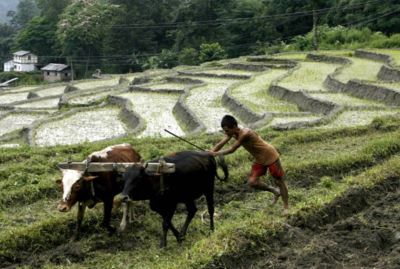Context-
The Vibrant Villages Programme (VVP) is a strategic initiative by the Indian government aimed at revitalizing and repopulating border villages that have been abandoned. This initiative is particularly crucial in light of China's establishment of Xiaokang villages near the Indian border, which poses significant strategic and security challenges for India. We look into the VVP’s objectives, the strategic importance of Xiaokang villages, the situation inside these villages, and how India can effectively counter China's salami-slicing tactics through robust border development.
Context and Importance of the Vibrant Villages Programme
● Abandonment of Border Villages
On July 12, 2024, the Rural Development and Migration Prevention Commission of India’s Uttarakhand State reported that 11 villages along the India-Tibet border in the Chamoli, Pithoragarh, and Uttarkashi districts had been abandoned. A survey conducted in the previous year revealed that three villages in Chamoli, six in Pithoragarh, and two in Uttarkashi were deserted. This alarming trend underscores the need for the Indian government’s VVP, launched in July 2023, aimed at preventing such occurrences by providing essential services and livelihood opportunities to encourage the repopulation of these border villages.
China's Xiaokang Villages
● Historical Background and Definition of Xiaokang
Xiaokang is an ancient Chinese social concept first mentioned in the "Shi Jing" (Book of Poems) nearly 2,000 years ago, symbolizing "modest happiness and comfort" for the common people. Over time, the term evolved, and Deng Xiaoping, China's paramount leader, described Xiaokang as a stage of economic development marked by a per capita income of US$ 800, a target China achieved in 1997. By 2024, China's per capita income has risen to approximately US$ 13,136.
● Xi Jinping's Vision for Xiaokang
In 2017, Chinese President Xi Jinping invoked the Xiaokang concept to address poverty and measure the quality of life in villages, emphasizing health, infrastructure, cultural and environmental progress, and income equality. This policy shift led to the development of border villages, aiming to enhance living standards and improve border management and security. As part of this program, China began developing 628 villages, primarily near its borders, with some in disputed territories, including Gyalaphug in Bhutan's Beyul region and villages near Uttarakhand’s Barahoti region, close to the Line of Actual Control (LAC).
Strategic Implications of Xiaokang Villages
● Expansion of Chinese Control and Military Presence
The establishment of Xiaokang villages near the Indian border represents a sophisticated strategy for extending China's de facto and de jure control over contested territories. These villages support strategic road networks and sustain military outposts in rugged, mountainous areas. Residents are encouraged to see themselves as "soldiers without uniforms," effectively turning each village into a fortress and each household into a watch post to guard China's borders. This strategy enhances China's security infrastructure and support system, following its philosophy of civil-military collaboration.
● Surveillance and Control within Xiaokang Villages
The actual population of Xiaokang villages often exceeds official figures, including temporary residents like construction workers, technical advisors, and security agents. A special unit of the border police is stationed in or around these villages to intercept Tibetans fleeing to India or Nepal. Residents form joint defense teams with the border security police to patrol neighboring mountains, resulting in more frequent PLA border patrols.
Additionally, village-based cadre work teams reside in these villages, rotating members every year or more. These teams guide the village committee and local Communist Party branch, providing political education and practical assistance. These regulatory agencies ensure strict surveillance and control over village residents.
● Legal and Diplomatic Implications
The establishment of village political units, postal networks, broadband connections, and permanent administrative apparatus helps China bolster its legal claims to these areas in the international arena. Since bilateral territorial negotiations typically avoid disturbing settled populations in disputed territories, these Xiaokang villages serve as quasi-legal instruments for China, adversely affecting India and Bhutan.
India's Countermeasures
● Strategic Responses to China's Tactics
To counter China's salami-slicing tactics, India must define and defend red lines, cultivate a reputation for unpredictability or occasional overreaction, and adopt a "swallowing as a whale" strategy to counter small territorial nibbles with significant territorial gains. The VVP represents a robust response to these tactics, aiming to repopulate frontier regions, expand state presence, and attract tourists, thereby bolstering India's territorial claims.
● Border Roads Organization (BRO) Achievements
The Border Roads Organization (BRO) plays a crucial role in enhancing infrastructure along the India-China border, significantly contributing to national security and regional development. As of September 2023, BRO has completed 90 infrastructure projects worth Rs 2,941 crore.
○ Trans-Arunachal Highway: This highway enhances connectivity across Arunachal Pradesh, facilitating troop movement and economic development.
○ Frontier Highway: Under construction to improve access and strategic connectivity along the India-China border.
○ East-West Industrial Corridor Highway: Focused on enhancing connectivity in the eastern part of Arunachal Pradesh and the Tawang region, this corridor supports both military and civilian logistics.
● Border Area Development Programme (BADP)
The Border Area Development Programme (BADP) is a centrally sponsored scheme designed to address the unique developmental needs of people living in remote and inaccessible areas near the international border. The programme's objectives include improving infrastructure and livelihoods to enhance the quality of life and security in border regions.
● Strategic Railways Development
Indian Railways is undertaking the construction of strategic rail lines in the Northeast region, aimed at facilitating the swift mobilization of the Indian army and improving regional connectivity.

Comparison between Indian Border Villages and Chinese Xiaokang Villages
● Voluntary Repopulation vs. Forced Settlement
A key difference between Indian border villages and Chinese Xiaokang villages is that in India, border populations abandon their villages due to a lack of facilities and livelihood opportunities. Providing basic amenities through the VVP would likely encourage them to return and reinhabit their homes. In contrast, Xiaokang villages are forcibly established, with the local border population compelled to remain and support the Chinese state and its agencies.
Conclusion
The Vibrant Villages Programme represents a strategic and comprehensive response to China’s Xiaokang villages and their associated challenges. By focusing on revitalizing and repopulating abandoned border villages, the VVP aims to enhance India’s security and strengthen its territorial claims. Effective implementation of the VVP, coupled with robust countermeasures to China’s salami-slicing tactics, can help India secure its borders and ensure the well-being of its frontier populations
|
Probable Questions for UPSC Mains Exam- 1. How does the Vibrant Villages Programme (VVP) aim to counter the strategic and security challenges posed by China's Xiaokang villages, and what are the key components of this initiative? (10 Marks, 150 Words) 2. In what ways do the approaches of India and China differ in their border village development strategies, particularly regarding the voluntary repopulation in Indian border villages versus the forced settlement in Chinese Xiaokang villages? (15 Marks, 250 Words) |
Source- ORF







